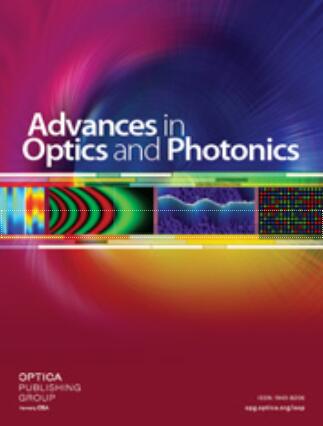光刻材料和应用:教程
IF 23.8
1区 物理与天体物理
Q1 OPTICS
引用次数: 11
摘要
晶体管使文明发生了革命性的变化。光子将使下一次革命成为可能,前提是光刻材料(将光能转化为机械能)可以大大提高效率。本教程开发了从微观起源到整体响应的照相力学响应的统一图片。光形态(最小的光力学材料单位)与体响应之间关系的统计模型为理解各种可能起作用的机制提供了背景。然后,我们介绍了如何测量光力学响应的实验细节,并用于推断潜在的机制。定义了光刻效率的优值,并对材料进行了评述。最后,我们描述了光机械器件(POD)以及如何将POD组合成高智能材料。本教程涵盖了(1)了解响应的基本物理原理,(2)设计和处理控制响应的材料,以及(3)构建新的设备和集成的光电系统所需的多学科主题。本文章由计算机程序翻译,如有差异,请以英文原文为准。
Photomechanical materials and applications: a tutorial
The transistor has revolutionized civilization. The photon will enable the next revolution provided that photomechanical materials, which convert light energy into mechanical work, can be made substantially more efficient. This tutorial develops a unified picture of the photomechanical response from its microscopic origins to the bulk response. A statistical model of the relationship between the photomorphon, the smallest photomechanical material unit, and the bulk response provides the context for understanding the various mechanisms that can contribute. We then present experimental details of how the photomechanical response is measured and used to deduce the underlying mechanisms. A figure of merit for the photomechanical efficiency is defined and materials are reviewed. Finally, we describe the photomechanical optical device (POD) and how PODs can be combined to form highly intelligent materials. This tutorial spans the multidisciplinary topics needed to (1) understand the fundamental physics of the response, (2) design and process materials to control the response, and (3) build new devices and integrated photomechanical systems.
求助全文
通过发布文献求助,成功后即可免费获取论文全文。
去求助
来源期刊

Advances in Optics and Photonics
OPTICS-
CiteScore
56.60
自引率
0.00%
发文量
13
期刊介绍:
Advances in Optics and Photonics (AOP) is an all-electronic journal that publishes comprehensive review articles and multimedia tutorials. It is suitable for students, researchers, faculty, business professionals, and engineers interested in optics and photonics. The content of the journal covers advancements in these fields, ranging from fundamental science to engineering applications.
The journal aims to capture the most significant developments in optics and photonics. It achieves this through long review articles and comprehensive tutorials written by prominent and respected authors who are at the forefront of their fields.
The journal goes beyond traditional text-based articles by enhancing the content with multimedia elements, such as animation and video. This multimedia approach helps to enhance the understanding and visualization of complex concepts.
AOP offers dedicated article preparation and peer-review support to assist authors throughout the publication process. This support ensures that the articles meet the journal's standards and are well-received by readers.
Additionally, AOP welcomes comments on published review articles, encouraging further discussions and insights from the scientific community.
In summary, Advances in Optics and Photonics is a comprehensive journal that provides authoritative and accessible content on advancements in optics and photonics. With its diverse range of articles, multimedia enhancements, and dedicated support, AOP serves as a valuable resource for professionals and researchers in these fields.
 求助内容:
求助内容: 应助结果提醒方式:
应助结果提醒方式:


